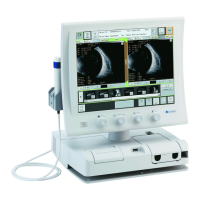3-115
■
4) Entry boxes for the acoustic velocities required for the measurement
conditions currently set appear. Enter the converted acoustic velocity for the
examined eye using the software keyboard being displayed at the same time.
5) Touch the “Ent (enter)” key to apply the setting and proceed to the next
entry box.
6) Selecting an IOL material and touching the “Setting Change” button (2)
shows it in the IOL material field (3). The entry can be changed in the
setting change screen.
7) Touch the “Incorporate in L” button (4) or “Incorporate in R” button (5) to
apply the data entered for the eye to the other eye. Touch the “Initial
Setting” button (6) to enter the initial settings.
(Initial setting and setting range of converted acoustic velocity)
Average acoustic velocity for axial length
Phakic eye : 1,550 m/s, 1,500 - 1,600 m/s
Dense cataract eye : 1,548 m/s, 1,500 - 1,600 m/s
Aphakic eye : 1,532 m/s, 1,430 - 1,630 m/s
Crystal lens acoustic velocity
Phakic eye : 1,641 m/s, 1,540 - 1,740 m/s
Dense cataract eye : 1,629 m/s, 1,540 - 1,740 m/s
Anterior chamber acoustic velocity
Phakic eye : 1,532 m/s, 1,430 - 1,630 m/s
Dense cataract eye : 1,532 m/s, 1,430 - 1,630 m/s
IOL eye : 1,532 m/s, 1,430 - 1,630 m/s
Vitreous acoustic velocity
Phakic eye : 1,532 m/s, 800 - 2,000 m/s
(in the case of divisional acoustic velocity)
IOL eye : 1,532 m/s, 800 - 2,000 m/s
IOL acoustic velocity
Acrylic resin : 2,200 m/s, 800 - 3,000 m/s
Silicone : 1,049 m/s, 800 - 3,000 m/s
PMMA : 2,718 m/s, 800 - 3,000 m/s
User setting : 2,200 m/s, 800 - 3,000 m/s
IOL thickness
Acrylic resin : 0.80 mm, 0.10 - 4.00mm
Silicone : 1.00 mm, 0.10 - 4.00mm
PMMA : 0.80 mm, 0.10 - 4.00mm
User setting : 0.80 mm, 0.10 - 4.00 mm

